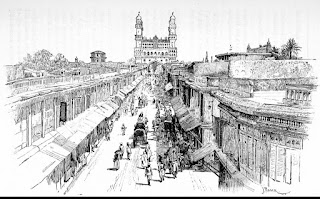Hyderabad State was a princely state located in the south-central region of India with its capital at the city of Aurangabad (1724-1798 AD) and at Hyderabad (1763-1948 AD). Of the 565 princely states in the British Empire, Hyderabad was the largest.
Hyderabad State was founded by Mir Qamar-ud-din Khan who was the governor of Deccan under the Mughals from 1713 to 1721. In 1724, he ruled under the title of Asaf Jah, granted by Mughal Emperor Muhammad Shah. His other title, Nizam ul-Mulk, became the title of his position ''Nizam of Hyderabad''. The native inhabitants of Hyderabad, regardless of ethnic origin, are called ''Mulki''(countryman), a term still used today.
Following the decline of the Mughal power, the region saw rise of Maratha Empire. Following the conquest of the Deccan by Bajirao I and imposition of ''chauth'' (tax) to the Marathas, the Nizam remained a tributary for all purposes. The senior most (23-gun) princely state in British India, Hyderabad was an 82,000 square mile (212,000 square km) region (larger than England and Scotland combined).
In 1798, Nizam Ali Khan (Asaf Jah II) was forced to enter into an agreement that put Hyderabad under the British protection and was rated a 21-gun salute during the period of British India. It remained a British ally in the Maratha Wars (1803-05, 1817-19), Anglo-Mysore wars and would remain loyal to the British during the Indian First War of Independence in 1857.
His son Asaf Jah III, known as Sikandar Jah, ruled from 1803 to 1829 and during his time a British cantonment was built and named in his honour as Secunderabad.
Asaf Jah V's reign from 1857 to 1869 was marked by reforms and organizational changes by his Prime Minister Salar Jung
Main street of Hyderabad with Charminar, 1890 AD
Hyderabad and Berar, 1903
The last Nizam of Hyderabad Mir Osman Ali Khan ruled from 1911 until 1948. He was given the title ''Faithful Ally of the British Empire''. During his time, Osmania University, Hyderabad State Bank, Hyderabad Aero Club, Begumpet Airport, Deccan Airways, Hospitals and lakes were developed. Many writers, poets, intellectuals and technocrats migrated from all parts of India to Hyderabad during his time. The last Nizam, Mir Osman Ali Khan was the world's richest man in the 1930s.
A locomotive at the Secunderabad Station, 1928 AD
In 1947 India gained independence and Pakistan came into existence. The Nizam decided not to join either. However, the Nizams were Muslim ruling over a predominantly Hindu population and India insisted that the majority wanted to join India. On 21 August1948, the Secretary General of the Hyderabad Department of External Affairs requested the President of the UN Security Council to settle the issue in accordance with international law. However, on 13 September 1948, under code-named Operation Polo, the Indian Army by 17 September incorporated Hyderabad with India
From 1948 to 1956, it remained as a state with its own Chief Minister. In 1956 during the reorganization of the Indian States, the state of Hyderabad was split up among Andhra Pradesh and Bombay state (later divided into states of Maharashtra and Gujarat in 1960 with the original portions of Hyderabad becoming part of the state of Maharashtra) and Karnataka.
On 02 June 2014, the state of Telangana was formed splitting from the rest of Andhra Pradesh state and formed the 29th state of India, with Hyderabad as its capital.
Hyderabad state, Mir Mahbub Ali Khan, 1/16 Rupee, silver, weight 0.7 g
Obverse: Legend in urdu, 92 Asaf Jah, Nizam Al-Mulk Bahadur, Persian letter ''M'' for Mahbub, AH 1299
Reverse: Legend in urdu, Julus Maimanat Manus Zarb Farkhanda Bunyad-Hyderabad
Hyderabad state, 1 anna, Mir Usman Ali Khan, 1920-1935, copper-nickel, weight 3.6 g
Obverse: Tughra 92, Asaf Jah Nizam Al- Mulk Bahadur, AH 1338
Reverse: Denomination in center, flanked by ''Yek Anna'' in urdu on the right, ''Sikka Usmania'' on left
Hyderabad state, 1 Rupee, Mir Mahbub Ali Khan, 1895-1901, silver, weight 11.1 g
Obverse: Legend in Urdu, Asaf Jah, Nizam Al-Mulk bahadur Persian letter M for Mahbub above ''k'' of ''Mulk'' AH 1312
Reverse: Legend in Urdu 28 Julus Maimanat Manus Zarb Farkhanda Bunyad, RY 28
Hyderabad was the only independent state which had its own currency.
Hyderabad state, 1919, Five rupee note.
Hyderabad state, 1000 Rupee note, 1929-1930,
Hyderabad state, 10 Rupee note, 1945.
Postage stamps of Hyderabad State
First stamp of Hyderabad, 1869
Hyderabad state, 1 anna 1931, courtesy The Ewari Collection
Hyderabad state, 1871, 2 annas
Hyderabad state, 1871-1909, 1/2 anna brown red






































No comments:
Post a Comment
Any inputs or feedback is welcome!